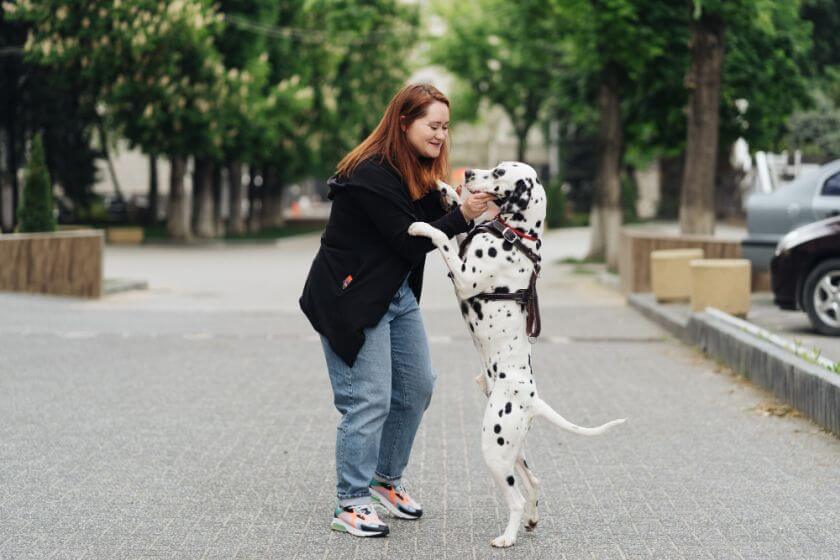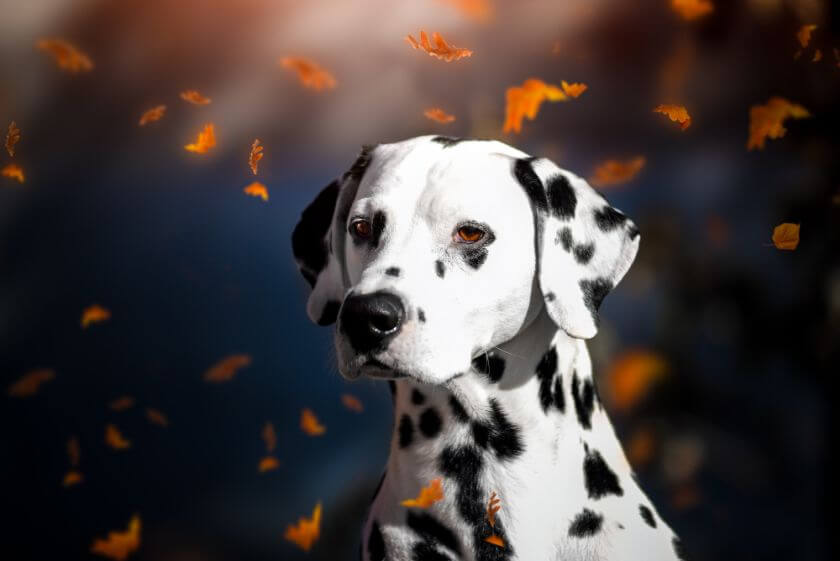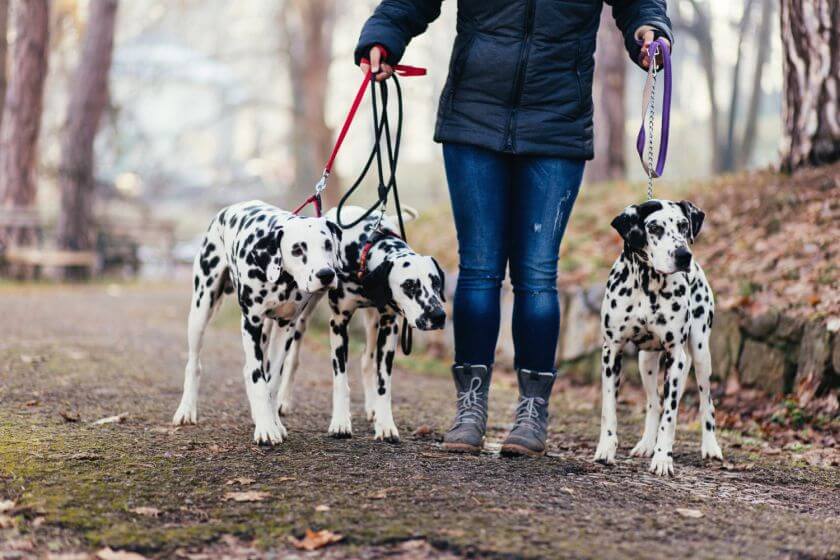The Dalmatian is a beautiful dog with a happy and playful disposition, best known for its unique white coat with black or brown spots. This dog breed requires proper upbringing and care, but rewards the attention it gets with love and unconditional loyalty!
Late in 1996, Disney released a live-action remake of the beloved animated film “101 Dalmatians”. Less than a year later, animal shelters across the United States began reporting a drastic increase in abandoned Dalmatian puppies. This was simply a result of misinformation. Motivated by the films, excited first-time Dalmatian owners lacked the knowledge and standards required to care for this beautiful, energetic breed.
But with their gorgeous spotted coat, regal carriage, and a love for running, Dalmatians are one of the most rewarding pets. Are you ready to take care of this beautiful breed? Read through our comprehensive guide to find out if you have what it takes.
Dalmatian Appearance

Dalmatians are, of course, identified by their distinct black-and-white spotted coat. They have a medium to large size – packing in about 48-55 pounds in a body between 19 and 24 inches tall. Females tend to be smaller in size. With an upright posture that matches their lean yet muscular build, these dogs look nothing short of regal.
Coat
The fur of a Dalmatian is short yet dense, fine yet smooth (almost like velvet!). You might come across a long-haired Dalmatian or two, but this is rare. Long or short fur, Dalmatians shed heavily throughout the year. Not to mention, they require frequent grooming. So, if you or any of your family members are allergic or have any issues with stray dog fur, don’t opt for a Dalmatian pet.
Color
Most Dalmatians are white with black spots, but some have spots in other colors as well. According to AKC standards, they can come in brindles, oranges, or tricolors. Puppies are usually born with white fur. Their spots typically don’t appear before the age of about 10 days or so.
Dalmatian Temperament

Due to their origins as coaching dogs, Dalmatians are a highly active breed. They love to run and exercise, so if you want a healthy Dalmatian, you must be able to provide them opportunities to do just that. They’re an inquisitive and intelligent breed. This means that they require mental stimulation, as well as the physical kind.
This should come as good news because it means that they can be trained quite easily. You must start teaching them at an early age, however. They also make excellent watchdogs and guard dogs due to their alertness.
Another important Dalmatian characteristic is their friendliness and love for their owners. They enjoy spending time with their owners and other members of their household. If you get a Dalmatian, you’ll find that it will spend most of its time by your side. Most people enjoy this, but it also means a risk of separation anxiety – so don’t neglect your spotted pup.
Do Dalmatians sound very high-maintenance at this point? Well, they certainly can be. But not if you make it a point to train and socialize them properly from a young age. If you fail to do so, you will most likely end up with a fussy, stubborn, and possibly aggressive Dalmatian.
Dalmatian Health

It is imperative to give your Dalmatian dogs the exercise and mental stimulation they need to keep them healthy. You must also know about the genetic illnesses that they are predisposed to. Ideally, you should have your Dalmatian’s health information on hand before you adopt it, but in case you don’t, here’s what to look out for.
Diseases
Unfortunately, questionable breeding practices have made it somewhat common for Dalmatians – like all purebred dogs – to suffer from certain genetic illnesses and afflictions:
- urolithiasis – the Dalmatian’s unique urinary tract system makes them likely to suffer from urolithiasis, a condition when urinary stones are formed. That is why it is crucially important to ensure that your Dalmatian always has access to clean, fresh water,
- deafness – these dogs are highly prone to deafness, with up to 24% of them being born with only one properly functioning ear. Meanwhile, 8% of all Dalmatians are born entirely deaf. Most experts say that it’s best to euthanize a deaf Dalmatian due to training difficulties and aggression. However, many Dalmatian lovers claim that you can still train a deaf dog using vibrations, hand movements, and of course, love and effort,
- hip dysplasia – this condition occurs when a dog’s thigh bone does not fit snugly into its hip joint. This might lead to lameness or pain in one or both of its rear legs,
- elbow dysplasia – common amongst large breed dogs. It is typically attributed to fast growth rates. Surgery can fix this problem,
- Von Willebrand’s disease – a blood disorder that is found in humans as well as dogs. Unfortunately, there is no cure for it, although it can be treated with surgery,
- hypothyroidism – this is the name given to underactive thyroids. It leads to obesity, infertility, fatigue, and mental incapacity. Medication exists for this condition,
- skin allergies – these dogs are also prone to skin allergies. Treatment depends on their cause and severity.
Life Expectancy
A well-cared-for Dalmatian will live between 12 to 16 years.
Owning a Dalmatian and Caring for Them

We’ve finally come to the part you’ve probably been waiting for: the care and upbringing of Dalmatians.
Exercise
One of the essential aspects of raising a happy and healthy Dalmatian is granting it lots and lots of physical stimulation, i.e., exercise. It would be best if you aimed to walk your Dalmatian at least twice a day (more is always better!). These dogs make lovely pets for active households. They are perfect for those who love to go running, hiking and jogging. Their intelligence also makes Dalmatians eager and quick learners, making them ideal for sports such as flyball.
Nutrition and Diet
Adult Dalmatians must be fed at least twice a day. They will usually require up to 2 cups of high-quality dog food per day. However, this amount can vary and should be based on the dog’s age, activity level and weight.
It is imperative to ensure that you avoid purine-rich food (such as organ meats) for your Dalmatian, as this might lead to urolithiasis. In order to grow and be healthy, your Dalmatian requires quality protein in their diet. So, make sure you give them low-purine protein like turkey, chicken or fish. And as we have mentioned above, make sure that your Dalmatian always has access to clean and fresh water.
Training and Socialization
As intelligent, active, and friendly dogs, Dalmatians are highly trainable… but only for a limited time. You should start training your Dalmatian from a very young age, no later than 3 months. If you wait too long, you might end up with a Dalmatian that is stubborn, disobedient, and headstrong.
The best way to train a Dalmatian is through positive reinforcement (i.e., reward-based training involving treats and praises). Showing anger, frustration or hostility is never recommended with any dog. This is especially applicable for Dalmatians because they have difficulty recovering from harsh treatment or negative reinforcement.
Although they are very social, these dogs require socialization from an early age. Let them meet new people and animals when they are still young. Make sure you do this in controlled, calm circumstances. An adaptable Dalmatian is a happy Dalmatian.
Compatibility
As you already know, Dalmatians thrive when they are placed in active households. If you and your family members love to spend time in the great outdoors, these dogs will make wonderful canine companions for you. Due to their high levels of energy, this breed should not even be considered by people leading mostly sedentary lifestyles or those without time for their dogs’ physical needs. If they are not adequately stimulated, they get bored and may become destructive.
They also shouldn’t be left unsupervised with children, unless they have been socializing with them since they were puppies. That said, a well-trained Dalmatian will make a great companion for children!
Dalmatians love their humans. And this means that they do not take well to being left alone. We understand it’s not possible to be with your dog at all times, however. So, if you absolutely must leave your Dalmatian alone, make sure they have a lot of space to play in and many toys to keep their mind busy.
Grooming
As heavy shedders, Dalmatians must be groomed regularly. A Dalmatian should be brushed at least once a week throughout the whole year. If you have a long-haired Dalmatian, though, you should aim to brush it much more frequently. But no matter the length of your Dalmation’s coat, don’t be surprised if you have to vacuum your house regularly.
Dalmatians typically don’t require many baths, since their coats naturally repel dirt and they don’t have a stinky odor. In fact, your Dalmatian does not need to be bathed more than 3-4 times a year. Excessive bathing can take away the natural oils in their coat which are essential to maintain their smooth shininess.
Their nails should be trimmed at least once or twice a month. Every now and then, check your Dalmatian’s ears for signs of infection. These typically manifest in crumbly, smelly gunk that can usually be cleaned with a washcloth soaked in warm water.
Breeding
You must be very careful when it comes to breeding Dalmatians. Remember, they have a genetic predisposition to both deafness and urinary stones. So, when you’re choosing a male and female Dalmatian for breeding purposes, your first job is to ensure that they are perfectly healthy. To do this, we recommend visiting a vet.
Look into your chosen Dals’ parents’ behaviors as well. Are they aggressive? Are they easy to train? Are they more suitable as companion/family dogs or as watchdogs? The answers to these questions will determine the kind of Dalmatian puppy you can expect from your chosen Dalmatian bitch and stud. You decide which traits you want your Dalmatian pups to retain, so choose their parents accordingly.
On average, you can expect the female Dalmatian to produce about 7 to 9 puppies in one litter. Anything above that quantity is rare. A Caesarean section will typically not be necessary.
Dalmatian Price
A Dalmatian rescue is the best way to get a dog if you are concerned about the price of buying one. However, be warned that if you adopt an adult Dalmatian which was not trained as a puppy, you may have a more challenging time raising it. But remember, you will be giving the dog a home, and possibly saving it from being put down.
If you’re looking for Dalmatian breeders, you could pay anywhere between $800 and $1500. A suspiciously low price could mean that your Dalmatian was born on a puppy farm. You must ensure that your Dalmatian’s parents are both healthy dogs if you want to avoid complications down the line.
The History of the Dalmatian Dog Breed
The origins of Dalmatians remain mostly unknown. They were first recorded as Romani companions. Their name is derived from the geographical area “Dalmatia,” known today as Croatia.
In the past, they have served as carriage dogs, shepherd dogs, guard dogs, retriever dogs, and circus dogs. The Dalmatian’s career as coach dogs was most common in England, where they would run alongside horse-drawn carriages of the wealthy, aristocratic members of society. It was not only for guarding purposes, but also to accentuate status. At night, the dogs would sometimes guard horses, which explains why even modern Dalmatians are fond of these animals.
In the United States, they were mainly used as fire station dogs. They accompanied fire engines to missions and assisted them according to their needs. To this day, you will find numerous fire stations with Dalmatians as their mascots.
Who Are Dalmatians For?
As you may have guessed by now, Dalmatians don’t make good pets for the faint-hearted. They require lots of exercise, care, mental stimulation and affection. We suggest this breed for those with active lifestyles. Large families also do well with Dalmatians which have been properly and carefully trained since their puppy days. Dalmatians are most suitable for experienced dog owners. If you are looking for your first dog, Dalmatians may not be the best breed given how high-maintenance they can be.
Some Trivia about Dalmatians
Can’t get enough of Dalmatians? Neither can we. Here are a few extra tidbits about this beloved breed.
- They’re an all-purpose breed – Dalmatians are very versatile, as you already know. They can guard your home and be your hiking partner, and they can even be your hunting companion. They also perform well in the circus and as show dogs.
- Some believe that Dalmatians existed in ancient Egypt – this is due to the existence of ancient Egyptian paintings depicting spotted dogs drawing chariots.
- There are even lemon Dalmatians – also known as the “Lemon dally”, a lemon Dalmatian is a variation with a pale, yellow-spotted coat. Such an unusual coat is the result of a genetic mutation.
- They were bred to accompany carriages – when Dalmatians arrived in England, they were used as coach dogs who would run alongside carriages in order to keep the people inside safe. That’s what gives them their love of exercise!
- Their spots are totally unique – just like your fingerprint or the shape of a snowflake, the spots on a Dalmatian’s body are entirely their own. Although black and white Dalmatians are most common, you might also come across a brown Dalmatian or two!
- They have many nicknames – Dalmatian names have significantly varied throughout the course of their existence, depending on the location. They have been known as the English firehouse dog, carriage dog, etc.
- The Budweiser Clydesdales have had the Dalmatian as their mascot since 1950. This is due to their history of guarding and protecting the wagon carrying the team to their games.
Disney is responsible for the popularity of Dalmatian dogs. But they’re more than just cute, spotted pets. While they are friendly and loyal, Dalmatians also require heavy training and lots of affection. Now that you know everything there is to know about Dalmatians, you are finally ready to make the decision – is a Dalmatian the right dog for you?
Similar Posts:
- 101 Dalmatians Dog Names: The Full List of Revealed Puppy Names
- A Dalmadoodle is a Dalmatian Poodle Mix and if You Haven’t Heard of Such a Dog Breed, It’s Time to Discover Dalmadoodles
- Black and White Dog Names Not Only for Dalmatians!
- Cutest Dog Breeds – Which Dogs are the Cutest According to Science?
- Irish Red and White Setter Dog Breed Information. Are You Curious About This Puppy’s Temperament and Care Needs?
- Cheetoh Cat Breed Information: What You Don’t Know About the New and Unique Cheetoh Breed
- The Miniature Bull Terrier Dog Breed: The Smaller Version of the Mischievous Bull Terrier
- The American Cocker Spaniel – One of America’s Favorite Dog Breeds

